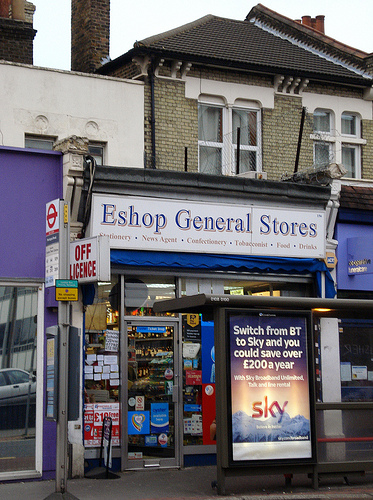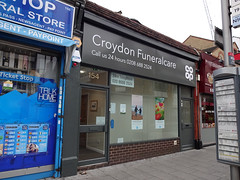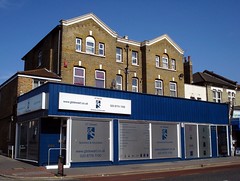E Shop General Store is a small convenience store at 156 London Road.
1860s–1890s: Arundel House
Looking at the upper floors of numbers 152–162 today, there’s a clear difference between number 156 and the rest of the block. Number 156 is narrow, low, and flat-roofed, unlike the higher peaked roofs above numbers 152–154 and 158–162, and looks almost like a slab of “filler” stuffed into the gap between two houses.
This is in fact a pretty good description of its original construction. Until the early 1900s, the land now occupied by 156 London Road formed part of the garden of Arundel House, a semi-detached property constructed in the mid-1860s on part of the recently broken-up Oakfield Estate.[1]
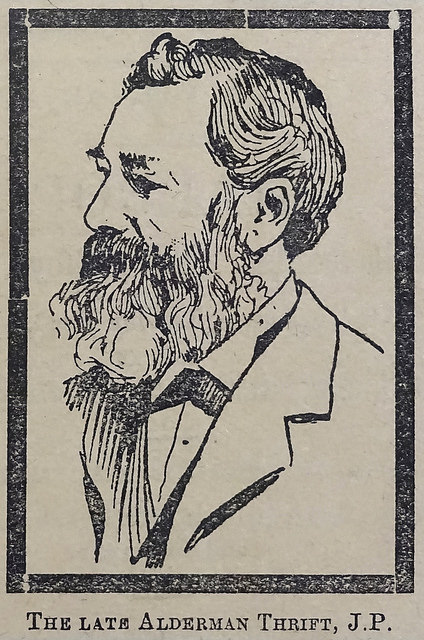
1870s–1880s: Jane and Margaret Bonus; John Thrift
By 1871, Arundel House was occupied by Jane and Margaret Bonus, a pair of sisters in their late 60s/early 70s who lived here with a housekeeper of around the same age and two teenaged servants.[2] The sisters remained at Arundel House until the late 1870s, but died here within a couple of months of each other in August and October 1878.[3]
Next to arrive was John Thrift, a wholesale grocer who remained here until around 1887, when he moved a few doors down to a house that later became 144–150 London Road.[4]
1880s–1890s: Alfred George Roper
John’s replacement was retired surgeon Alfred George Roper. Born in Shoreditch around 1819, Alfred trained at Guy’s Hospital and qualified as MRCS (Member of the Royal College of Surgeons) and LSA (Licentiate of the Society of Apothecaries) in 1840. By 1851 he was married with two children, and living and practising at 112 High Street, Croydon.[5] He later entered into partnership with a younger surgeon, Henry Horsley, who was also a London Road resident.[6]
In 1867, Alfred and eleven other Croydonians opened a new hospital on Duppas Hill. Known as Croydon General Hospital, this was intended for “the relief of those sufferers whose circumstances will not allow them to obtain necessary medical treatment, but whose social position is above that of paupers”. Seven years later, it moved to premises on London Road, just a few doors south from Arundel House.[7]
Alfred served both as medical officer to the hospital and as honorary secretary of the hospital committee. In the latter capacity, he was presented in 1875 with a “testimonial” by “the friends of the Croydon General Hospital, in acknowledgement of invaluable services rendered by him as Honorary Secretary to that institution”. The testimonial consisted of “a rosewood oblique grand pianoforte, with music cabinet, a silver tea- and coffee-service, with tray and salver, a handsome drawing-room clock, and vases to match.” Recognition of his work came from outside Croydon, too; in the same year, he was elected a Fellow of the Royal College of Surgeons.[8]
Alfred retired as a surgeon around the end of the 1870s, and moved to Arundel House around 1887. He continued to serve as honorary secretary of the General Hospital until 1890, when “from failing health” he “found it necessary to resign his position [...] which he has held with much advantage to the Institution ever since its inception”. He was, however, “formally elected a vice-president of the Hospital” in recognition of his years of service.[9] He died at Arundel House, like the Bonus sisters; in his case, on 13 April 1896 at the age of 77.[10]
1890s–1900s: Robert Hooper
Next to move in to Arundel House — and the last to use it as a purely private residence — was Robert Hooper, a draper’s assistant in his late 40s who lived here with his wife Elizabeth and at least three children. Given the social class of the previous residents of the house, one can assume that Robert was a fairly senior “assistant”, likely working at a high-class drapery and thus relatively well-paid. The Hoopers moved in by late 1896 and remained until around 1901.[11]
1900s: West Croydon School
By 1903, Arundel House was home to West Croydon School, a day school for boys run by John Colin Harris Neech. The school aimed “to prepare Boys for Professional and Commercial Pursuits”, and paid “Special attention [...] to delicate and backward boys”. Initially established at 52 Wellesley Road in the mid-1880s, it moved to 98 Oakfield Road in 1888 and spent around a decade and a half there before moving again to London Road.[12]
Around the same time as moving his school to London Road, John married Maria Theresa Wratten.[13] It’s not clear whether this had any connection to his decision, a couple of years later, to give up running the school; but in any case, by 1905 John and Maria had departed London Road. West Croydon School passed into the hands of Reverend Hamlin Hubert Jones, who continued to run it here for a couple of years before moving it to Tavistock Road.[14]
Hamlin was a Welshman, born in Llandovery around 1876. In 1899, he was ordained as a deacon and licensed to the curacy of St Catherine in Milford Haven. It isn’t clear how he came to be running a school in Croydon, but in any case by 1910 he had handed the school — now at 11 Tavistock Road and known as Modern School — over to the partnership of F W Cape and W B Shore, and by 1911 he had returned to the Church and was working as a clergyman in Selsey, Sussex. He was ordained as a priest in 1912.[15]
1900s: Extension and conversion to shops
Significant changes took place for Arundel House and its neighbours after the departure of West Croydon School. All three houses — the semi-detached pair of Eton House and Arundel House, and the detached St Elmo just to the south — were extended forward to the present pavement line, and a narrow two-storey “filler” was constructed between Arundel House and St Elmo. The newly-extended buildings were split into a total of six shops, which today are numbered 152–162.[16]
(From here on, this article focuses on number 156, which as mentioned above was formed from the two-storey building constructed on what was previously part of the garden of Arundel House. I’ve already discussed numbers 152 and 154, and will cover numbers 158–162 in a future article.)
1900s: Ernest Blackhall and Miss E Masters, confectionery and tea rooms
Although number 156 was the smallest of the six new shops, its first proprietor managed to find space not only to sell confectionery but also to open a tea room. Ernest Blackhall was in place by 1908, but was swiftly replaced by Miss E Masters. By early 1911, however, both Miss E Masters and the tea room had departed.[17]
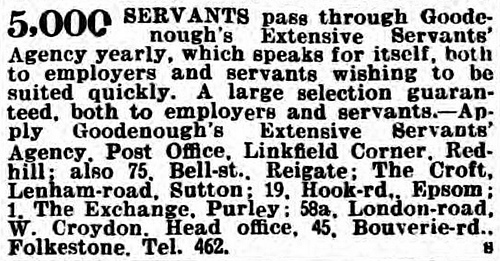
1910s–1930s: Confectionery and tobacco
The following decades saw little change in the main business of the shop, despite several changes in proprietor, initially quite swift ones: Selina Egg, Miss Caine, William H Money, and C E Rivers all came and went during the first half of the 1910s.[18]
One or more of these confectioners seems to have also acted as an agent for Goodenough’s Extensive Servants’ Agency, which had a head office in Folkestone and boasted of “5,000 servants pass[ing] through [...] yearly, which speaks for itself, both to employers and servants wishing to be suited quickly.” As well as the branch here on London Road, it also had a presence in Reigate, Sutton, and Purley.[19]
A little more stability arrived with John Albert Cruwys, in place by late 1916. This was not John’s first business venture in Croydon; he’d previously run a grocery shop at 134 Church Road from around 1892 to around 1902. John’s son William took over the London Road shop around 1919, and remained until around 1925 before moving to Brighton Road.[20]
The first documentary mention of tobacco being sold at the shop came with the arrival of Misses Morriss and Birbeck, listed in Ward’s 1926 directory as “Confctrs. & Tob.” [Confectioners and Tobacconists]. The “Misses” were replaced by Mrs Etterley a couple of years later, followed by Mrs Cole, C R Williams, and Mrs M Dancy. The final edition of Ward’s directories, published in 1939, lists simply “Honest, Confectioner”.[21]
1940s-1960s: Leo Gray, high-class confectioner and tobacconist
By the mid-1940s, the shop had been taken over by Leo Gray, a “High-Class Confectioner and Tobacconist” who also sold “fancy goods” and did “lighter repairs”. Leo remained here for over two decades, until the late 1960s.[22]
1980s–1990s: V Patel, Sachin’s News, Newsfare
It’s unclear who Leo Gray’s immediate replacement was, but by 1980 the shop was in the hands of the Patel family and was operating as a newsagent as well as a tobacconist and confectioner.[24] A Croydon Council planning officer gave a rather disapproving description of the shop around this time:
[...] an illuminated projecting box [sign] in the form of a cigarette packet [...] is positioned on the left-hand pilaster of the shopfront. [...] The shop is generally cluttered with advertising material e.g. freestanding boards, signs on stallriser and windows plus projecting ice cream sign. In the circumstances suggest refusal [of permission to retain the box sign] and action be taken to secure the removal of some of the rubish [sic].
The “clutter” had been removed by the time the Council made their next site visit in October 1982, so the officer now “could see no valid objection to presence of an ill. [illumated] proj. [projecting] sign. The majority of similar premises are of similar appearance & yet have such signs with consent.”[25]
Another planning application, submitted in 1983, requested permission for a new frontage sign with the name “Sachin’s News”.[26] However, by 1985 the shop was going under the name of “Newsfare”, which it retained until the late 1990s.[27]
2000s–present: E Shop General Store
By 2002, the shop was in the hands of Shaji Sreedharan, and had been renamed to Eshop. It was an off licence at this point, but likely also still sold newspapers, tobacco, and confectionery.[28] The building was also home to Computech Electronics, which had previously been down the road at number 27.[29]
Around 2008, Eshop was taken over by Mr Nawarathinam, who still runs it today, though under the slightly different name of E Shop General Store.[30]
The shop sells a wide variety of items, all cleverly fitted into the small, narrow space: household goods such as candles and rubber gloves; basic groceries such as eggs, bread, instant noodles, and fufu mix; chilled items such as pasties, sandwiches, and biryani; and the usual cigarettes, soft drinks, sweets, savoury snacks, and alcoholic drinks. Bus passes, Oyster top-ups, and photocopying services are also available.[31]
When I spoke to Mr Nawarathinam in April 2017, he told me that he’s always sold roughly the same sort of things, and has no plans to change this in the future — though he does expect his sales of soft drinks to go up once Harris Invictus opens its new, permanent secondary school a few doors along on the old General Hospital site.
Thanks to: Mr Nawarathinam of Eshop General Store; the Planning Technical Support Team at Croydon Council; the staff, volunteers, and patrons at the Museum of Croydon; and my beta-reader bob. Census data and London phone books consulted via Ancestry.co.uk. Monetary conversions performed using the Bank of England inflation calculator (prices < £100 given to the nearest penny, prices from £100 to < £100,000 to the nearest pound, prices from £100,000 to < £1 million to the nearest £1,000, prices from £1 million to < £100 million to the nearest £100,000, prices ≥ £100 million to the nearest million).
Footnotes and references
- The semi-detached pair of houses known as Arundel House and Eton House are shown (though without their names) on a plan included in particulars for a sale of building plots on 24 October 1867 (Museum of Croydon, drawer 39, map 12) — this plan is reproduced in my article on the General Hospital site. The last owner of the Oakfield Estate, Richard Sterry, died in February 1865, and the estate break-up postdated this. Hence Arundel House and Eton House must have been built in 1865, 1866, or 1867.
- The 1871 census lists Arundel House as being occupied by Jane Bonus (67, unmarried, head of the household), Margaret Bonus (71, unmarried, and Jane’s sister), a 70-year-old housekeeper with a name something like “Georgina Grix”, and two servants: Alice, aged 19, and Bertha, aged 15 (the names on this census are quite hard to read). It’s unclear why Jane is head of the household, since Margaret is older — and in fact in the 1861 census, when the sisters are living in Bow, Margaret is the head.
- According to the sisters’ entries in the National Probate Calendar, Jane died on 5 August, leaving effects of under £100 (under £10,923 in 2016 prices), and Margaret died on 7 October, leaving effects of under £1000 (under £109,000 in 2016 prices). Both died at Arundel House itself.
- Ward’s directories list John Thrift at Arundel House from 1880 to 1887 inclusive. Many more details on his life can be found in my article on 144–150 London Road.
- Ward’s directories list Alfred George Roper at Arundel House from 1888 to 1896 inclusive. The 1881 census (at which point he was living on North End) describes him as “Surgeon F.R.C.S. non practising”, so it seems he retired several years before his move to London Road. Gray’s 1851 directory lists Alfred George Roper, Surgeon, at 112 High Street; he also appears here in the 1851 census, along with his wife Caroline, two sons aged 6 months and 2 years respectively, his widowed mother, a cook, a housemaid, and a groom. His birthplace is listed differently in different censuses: Hackney in 1851 and 1871, Shoreditch in 1861 and 1891, and London in 1881. His age in all these censuses is consistent with a birth in 1818 or 1819. His place of training and date of qualification are taken from his obituary on page 1073 of the 25 April 1896 British Medical Journal, though it should be noted that this source contains at least one small inaccuracy: it states that Alfred practised in Croydon “at first in partnership wih Mr. Horseley [sic]”, whereas in fact he was working in Croydon by 1851 but Henry didn’t qualify until 1859.
- Henry spent around a quarter of a century on London Road, initially further south at number 76 but later at the other half of the Arundel House semi-detached pair, Eton House; the move to Eton House happened after Alfred’s death, though, so the two men never actually lived next door to each other. More information on Henry can be found in my article on 76 London Road. The partnership of Roper & Horsley is listed at 24 North End in Wilkins’ 1872–73 and Ward’s 1874 directories, and at Henry’s London Road house in Ward’s 1876 and 1878 directories. (An earlier directory, Warren’s 1869, lists Alfred and Henry at separate addresses: 57 and 24 North End, respectively.).
- See my article on the old General Hospital site for much more information on this.
- Information on the “testimonial” is taken from a notice on page 516 of the 17 April 1875 British Medical Journal.
- Regarding Alfred’s retirement date, the 1881 census (at which point he was living on North End) describes him as “Surgeon F.R.C.S. non practising”. See also the 1879 announcement of the dissolution of his partnership with Henry Horsley (reproduced here). Information on his resignation as honorary secretary and election as vice-president is taken from a report on the Croydon General Hospital annual meeting on page 6 of the 22 November 1890 Croydon Advertiser (viewed online at the British Newspaper Archive; requires subscription).
- Alfred’s death date and age at death are taken from an announcement on page 4 of the 18 April 1896 Sussex Agricultural Express, which states that he died “in his 78th year” (viewed online at the British Newspaper Archive; requires subscription). His British Medical Journal obituary (see earlier footnote) also gives his age at death as 77.
- Ward’s directories list Robert Hooper at Arundel House from 1897 to 1901 inclusive. All other information on the Hoopers is taken from the 1901 census.
Ward’s directories list John C Neech, Young Gents’ School, at 52 Wellesley Road in 1886; J C Neech, Young Gentlemen’s School, at 52 Wellesley Road in 1887 and 1888; J C Neech, Boys’ School, at 98 Oakfield Road from 1889 to 1893 inclusive; J C Neech, West Croydon School, at 98 Oakfield Road from 1894 to 1902 inclusive; and J C Neech, West Croydon School, at 58 London Road (the then-address of Arundel House) in 1903 and 1904. Regarding the move from Wellesley Road, it must have taken place before the end of 1888, since Oakfield Road in Ward’s 1889 directory is in a section dated 6 December 1888, but it also must have taken place after the start of 1888, since an advert for the school on page 4 of the 21 January 1888 Croydon Advertiser (viewed online at the British Newspaper Archive; requires subscription) gives the Wellesley Road address.
The 1891 census, when the school was at 98 Oakfield Road, gives J C Neech’s full first name of John, while the 1901 census has him as “John C H Neech”. His full middle names are taken from his entry in the National Probate Calendar (see next footnote for evidence that this is the correct John Neech). Neither of these censuses list anyone else at 98 Oakfield Road other than John, so he doesn’t seem to have taken any boarders. Quotations describing the school are taken from an advert (reproduced here) on the front page of the 1 January 1898 Croydon Advertiser (viewed online at the British Newspaper Archive; requires subscription). It isn’t clear why this advert states that West Croydon School was “Established [in] 1883”, since John Neech is absent from pre-1886 editions of Ward’s directories, and 52 Wellesley Road is vacant in the 1885 edition. John was certainly teaching by 1881, as the census of that year lists him as a “Teacher” in the “House attached to Board Schools” on Birchanger Road in Norwood.
- The 1911 census lists John Colin Neech and Maria Theresa Neech at 86 Haslemere Road in Thornton Heath; in addition to the match on names, John’s age and birthplace (Aylsham in Norfolk) match the John Neech at 98 Oakfield Road in 1901 and 1891. John Colin H Neech and Maria Theresa Wratten are both listed as appearing on page 706 of volume 2a in the England & Wales Civil Registration Marriage Index 1837–1915 for a marriage in Croydon in the third quarter of 1902. For more information on John’s family, see his page on the Neech family tree website.
John Neech is absent from Ward’s 1905 directory (including the alphabetical listings of residents, the alphabetical lists of professionals and tradesmen, and the classified lists of “Professors and Teachers of Language” and “Schools for Young Gentlemen”). However, as noted in the previous footnote, by 1911 he and Maria were living in Thornton Heath.
Ward’s directories list Rev. Hamlin Hubert Jones, B.A., at 58 London Road (the number assigned to Arundel House, later renumbered to 158) in 1905 and 1906, and at 11 Tavistock Road in 1907, 1908, and 1909. (The street-by-street listing in 1905 doesn’t mention the school, but the list of classified “Professions and Trades” does, under “Schools for Young Gentlemen”.) These directories don’t list the name of the school, but page 2 of the 20 February 1906 Surrey Mirror (viewed online at the British Newspaper Archive; requires subscription) has a “List of Successes” in the December 1905 Cambridge Local Exams which includes “J. R. Brumfit, West Croydon School (Rev. H. H. Jones, B.A.)”.
The “Schools for Young Gentlemen” section of Ward’s 1910 directory lists “Modern School” at 11 Tavistock Road with the names F W Cape and W B Shore, B.A.; see previous footnote for listings at 11 Tavistock Road under Hamlin’s name.
Regarding Hamlin’s biographical information, the 1911 census lists a 35-year-old “Clergyman Episcopalian” named Hamlin Hubert Jones, born in Llandovery, Camarthernshire, and then living in Selsey, Sussex, with his wife Gladys Enid Muriel Jones and sons Hubert Edgar Barnaby Jones (3 years, born in Croydon) and Roger Neville Jones (9 months). Hubert’s entry in the Surrey Church of England Baptism Register for 1908 (Parish of St James, Croydon, page 54, viewed online at Ancestry.co.uk) gives an address of Stanley House, Tavistock Road, and a father’s profession of “School Master”, confirming that this is the right Hamlin Hubert Jones. Information on his ordinations is taken from articles on page 6 of the 29 May 1899 South Wales Daily News and on page 8 of the 3 June 1912 Yorkshire Post and Leeds Intelligencer, respectively (viewed online at the British Newspaper Archive; requires subscription).
- See my article on 152 London Road for more on the extension and splitting of these buildings.
- Ward’s directories list Ernest Blackhall, “Confect. & Tea Room” in 1908, and Miss E Masters, “Confect. & Tea Room”, in 1909, 1910, and 1911. There is no mention of a tea room in any of the later editions.
- 43-year-old Selina Egg and her 20-year-old daughter Lena are listed at 58a London Road (later renumbered to 156) in the 1911 census. Although Selina’s status is “Married”, no mention is made of her husband, and I haven’t been able to find him anywhere else in this census. (The 1901 census shows Selina, her husband William H Egg, and their children, all living in Walthamstow.) Ward’s directories list “Confectioner’s Shop” in 1912; Miss Caine, Confectioner, in 1913; William H Money, Confectioner, in 1914; C E Rivers, Confectioner, in 1915; and “Unoccupied” in 1916.
- Information and quotation taken from an advert (reproduced here) on page 7 of the 27 July 1912 Dorking and Leatherhead Advertiser (viewed online at the British Newspaper Archive; requires subscription). I haven’t found any trace of Goodenough’s in Kelly’s 1911, Ward’s 1912, or Ward’s 1913 directories.
Ward’s directories list John A Cruwys, Confectioner, in 1917, 1918, and 1919; and W J Cruwys, Confectioner, from 1920 to 1925 inclusive. W J Cruwys then appears at 21 Brighton Road in 1926 and 1927.
Given the unusual surname, John A Cruwys is almost certainly the John Albert Cruwys born around 1859 in Newton Abbot, Devon, and listed as a “Shopkeeper Confectioner etc.” at 3 Lower Road, Sutton, in the 1911 census, and (as John A Cruwys) as a “Refreshment Caterer” at 134 Church Road, Croydon, in the 1901 census. The earlier of these two censuses also includes his 9-year-old son, William J Cruwys. I haven’t been able to find William in the 1911 census.
Ward’s directories list John Albert Cruwys, Grocer, at 134 Church Road from 1893 to 1902 inclusive. He is absent from the alphabetical listings of residents and tradesmen in 1903, and doesn’t appear in the Sutton section either.
- All information taken from Ward’s directories.
- Leo Gray is listed at 156 London Road in phone books from the 1946 London edition to the August 1967 Croydon edition inclusive. He also appears in Kent’s 1955 and 1956 directories as a “Tobacconist & Confectioner”. Quotations in the main text are taken from the headed notepaper reproduced here.
- This is my sketch, from the microfiche record of planning application A1566, viewed at Croydon Council offices. Most of this record is unfortunately illegible. The quotation describing the sign comes from the index card for 156 London Road.
- Brian Gittings’ 1980 survey of central Croydon retail lists “V Patel — newsagent” (and comparison with other entries shows this is definitely a “V” rather than “U”, as he makes his “U”s very differently). Phone books list U H Patel, Nwsagt Tbcnst Confec [newsagent, tobacconist, and confectioner] from the October 1980 Bromley/Orpington edition to the April 1984 Croydon edition inclusive. Taken together, this suggests the involvement of more than one Patel.
- Quotations are all taken from planning application ref A81/255. The report of the second site visit begins: “Visited site 8/10/82 and observed clutter removed”. A drawing included in this application shows that the “cigarette packet” sign was a Marlboro one.
- Planning application ref 83/201/A; a sketch of the proposed sign is reproduced here. It’s worth noting that I can’t confirm this was ever put in place. The name “Sachin” is absent from the 1982 Croydon phone book, the May 1983 Caterham & Reigate phone book, and the April 1984 Croydon phone book, though all three list U H Patel as a newsagent/tobacconist/confectioner at 156 London Road.
- Newsfare is listed in Croydon phone books from 1985 to 1998 inclusive. It also appears in a listing of bus pass and travelcard agents on page 18 of the 3 August 1990 Croydon Advertiser, in the newsagents section of the 1995–6 Croydon Local directory (Yellow Pages), and in the newsagents section of the first and second editions of Shop ’Til You Drop (probably published around 1998–1999 and 2002, respectively).
- Eshop and its owner are mentioned in an article in the 25 February 2002 Evening Standard (“Phone victim came close to death”, viewed online on the Evening Standard website). The article describes Eshop as an off licence.
- Croydon phone books list Computech Electronics at 27 London Road up to and including 1998, and at 156 London Road from 1999 to 2009–2010 inclusive. According to the second edition of Shop ’Til You Drop (probably published around 2002), Computech Electronics unsurprisingly dealt in “computers/software”. Shaji Sreedharan, Eshop, and Computech Electronics are all mentioned as respondents in a domain name dispute from 2002, so there seems to have been some connection between them.
Mr Nawarathinam told me in April 2017 that he took over the shop nearly 10 years previously (in-person conversation, 4 April 2017). He is also mentioned as the “owner of Eshop General Stores” in an article in the 24 August 2008 Croydon Advertiser (“Shopkeepers fuming over cigarette plan”, available at the Internet Archive).
From my personal observation (and photos), the change of name from Eshop General Stores to E Shop General Store seems to have happened between January 2012 (pictured here) and June 2014 (see my photo from that month).
- All information in this paragraph is from personal observation.
